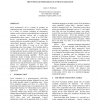66 search results - page 8 / 14 » Power Domination in Product Graphs |
ACL
2008
13 years 9 months ago
2008
We present a novel approach to weakly supervised semantic class learning from the web, using a single powerful hyponym pattern combined with graph structures, which capture two pr...
COMBINATORICS
1998
13 years 7 months ago
1998
Voltage graphs are a powerful tool for constructing large graphs (called lifts) with prescribed properties as covering spaces of small base graphs. This makes them suitable for ap...
JMLR
2006
13 years 7 months ago
2006
We present a new framework based on walks in a graph for analysis and inference in Gaussian graphical models. The key idea is to decompose the correlation between each pair of var...
WAOA
2004
Springer
14 years 24 days ago
2004
Springer
Borodin, Nielsen and Rackoff [5] proposed a framework for ing the main properties of greedy-like algorithms with emphasis on scheduling problems, and Davis and Impagliazzo [6] ext...
WSC
1997
13 years 8 months ago
1997
Proof Animation™ 4.0 is a family of products for animating discrete event simulations. Proof is available in a variety of versions, including an inexpensive, student version, mi...

